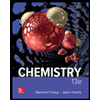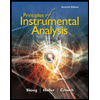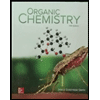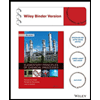
Connect 2-Year Online Access for General, Organic, and Biochemistry
9th Edition
ISBN: 9781259677946
Author: Denniston
Publisher: Mcgraw-hill Higher Education (us)
expand_more
expand_more
format_list_bulleted
Question
Chapter 9, Problem 9.48QP
Interpretation Introduction
Interpretation:
Concept Introduction:
Nuclear equation can be written for nuclear reactions. Neutrons do not possess any
Expert Solution & Answer
Want to see the full answer?
Check out a sample textbook solution
Students have asked these similar questions
Using the appropriate bond energies, calculate the heat of reaction AH for the following reaction:
H-H + CI-CI
2 H-CI
You can find a table of bond energies by using the Data button on the ALEKS toolbar.
Round your answer to the nearest kJ/mol.
Note: For clarity, all lone pairs have been omitted from the molecular structures.
☐
kJ
mol
ค
000
Ar
B
Predict the hydrocarbon, of formula C6H10, needed to prepare the following geminal dibromide upon treatment with excess hydrobromic acid.
Note: The shown product is the only regioisomer formed in this reaction.
HBr
H₂C.
CH3
draw the major product formed with the listed reagents
Chapter 9 Solutions
Connect 2-Year Online Access for General, Organic, and Biochemistry
Ch. 9.1 - Gamma radiation is a form of electromagnetic...Ch. 9.1 - Prob. 9.2QCh. 9.2 - Prob. 9.1PPCh. 9.2 - Prob. 9.3QCh. 9.2 - Prob. 9.4QCh. 9.2 - Prob. 9.2PPCh. 9.2 - Prob. 9.5QCh. 9.2 - Prob. 9.6QCh. 9.2 - Prob. 9.3PPCh. 9.2 - Prob. 9.7Q
Ch. 9.2 - Prob. 9.8QCh. 9.3 - Prob. 9.4PPCh. 9.3 - Prob. 9.9QCh. 9.3 - Prob. 9.10QCh. 9.5 - Prob. 9.11QCh. 9.5 - Prob. 9.12QCh. 9.6 - Prob. 9.13QCh. 9.6 - Prob. 9.14QCh. 9.7 - Prob. 9.15QCh. 9.7 - Prob. 9.16QCh. 9 - Prob. 9.17QPCh. 9 - Prob. 9.18QPCh. 9 - Prob. 9.19QPCh. 9 - Prob. 9.20QPCh. 9 - Prob. 9.21QPCh. 9 - Prob. 9.22QPCh. 9 - Prob. 9.23QPCh. 9 - Prob. 9.24QPCh. 9 - Prob. 9.25QPCh. 9 - Prob. 9.26QPCh. 9 - Prob. 9.27QPCh. 9 - Prob. 9.28QPCh. 9 - Prob. 9.29QPCh. 9 - Prob. 9.30QPCh. 9 - Prob. 9.31QPCh. 9 - Prob. 9.32QPCh. 9 - Prob. 9.33QPCh. 9 - Prob. 9.34QPCh. 9 - Prob. 9.35QPCh. 9 - Prob. 9.36QPCh. 9 - How many protons and neutrons are contained in...Ch. 9 - How many protons and neutrons are contained in...Ch. 9 - Prob. 9.39QPCh. 9 - Prob. 9.40QPCh. 9 - Prob. 9.41QPCh. 9 - Prob. 9.42QPCh. 9 - Prob. 9.43QPCh. 9 - Prob. 9.44QPCh. 9 - Prob. 9.45QPCh. 9 - Prob. 9.46QPCh. 9 - Prob. 9.47QPCh. 9 - Prob. 9.48QPCh. 9 - Prob. 9.49QPCh. 9 - Prob. 9.50QPCh. 9 - Prob. 9.51QPCh. 9 - Prob. 9.52QPCh. 9 - Prob. 9.53QPCh. 9 - Prob. 9.54QPCh. 9 - Prob. 9.55QPCh. 9 - Prob. 9.56QPCh. 9 - Prob. 9.57QPCh. 9 - Prob. 9.58QPCh. 9 - Prob. 9.59QPCh. 9 - Prob. 9.60QPCh. 9 - Prob. 9.61QPCh. 9 - Prob. 9.62QPCh. 9 - Prob. 9.63QPCh. 9 - Prob. 9.64QPCh. 9 - Prob. 9.65QPCh. 9 - Prob. 9.66QPCh. 9 - Prob. 9.67QPCh. 9 - Prob. 9.68QPCh. 9 - Prob. 9.69QPCh. 9 - Prob. 9.70QPCh. 9 - Prob. 9.71QPCh. 9 - Prob. 9.72QPCh. 9 - Prob. 9.73QPCh. 9 - Prob. 9.74QPCh. 9 - Prob. 9.75QPCh. 9 - Prob. 9.76QPCh. 9 - Prob. 9.77QPCh. 9 - Prob. 9.78QPCh. 9 - Prob. 9.79QPCh. 9 - Prob. 9.80QPCh. 9 - Prob. 9.81QPCh. 9 - Prob. 9.82QPCh. 9 - Prob. 9.83QPCh. 9 - Prob. 9.84QPCh. 9 - Prob. 9.85QPCh. 9 - Prob. 9.86QPCh. 9 - Prob. 9.87QPCh. 9 - Prob. 9.88QPCh. 9 - Prob. 9.89QPCh. 9 - Prob. 9.90QPCh. 9 - Prob. 9.91QPCh. 9 - Prob. 9.92QPCh. 9 - Prob. 9.93QPCh. 9 - Prob. 9.94QPCh. 9 - Prob. 9.95QPCh. 9 - Prob. 9.96QPCh. 9 - Prob. 9.97QPCh. 9 - Prob. 9.98QPCh. 9 - Prob. 9.99QPCh. 9 - Prob. 9.100QPCh. 9 - Prob. 9.101QPCh. 9 - Prob. 9.102QPCh. 9 - Prob. 9.103QPCh. 9 - Prob. 9.104QPCh. 9 - Prob. 1CPCh. 9 - Prob. 2CPCh. 9 - Prob. 3CPCh. 9 - Prob. 4CPCh. 9 - Prob. 5CPCh. 9 - Prob. 6CPCh. 9 - Prob. 7CP
Knowledge Booster
Similar questions
- Propose Williamson ether syntheses for the following compoundsarrow_forwardIdentify all functional groupsarrow_forwardA mixture of CaCO3 and MgC2O4 of unknown mass was heated in a 0.5 L closed rigid vessel to 900 degrees C.at 400C the following reaction occurs:MgC2O4 -> MgO (s) + CO (g) + CO2 (g)At 700C a second reaction occurs: CaCO3 -> CaO (s) + CO2 (g)The solid mass in the vessel was measured to be 3.06 g at 400C and 2.03g at 900CQuestion: What is the partial pressure of CO in both temperatures? (400 and 900C), provide detailed explanation.arrow_forward
- For the following alkyne, complete the reaction sequentially (that is draw the intermediate that we can’t stop at) and then name (complete name) all 3 molecules.arrow_forwardGiven the reaction sequence below, answer the following. A. Provide the structure for A. B. Provide the structure for B (pay attention to stereochemistry). C. Provide the structure for C. D. What are the stereochemical designations for I and II (R/S)?arrow_forwardWhich of the following is the most stable carbon radical?arrow_forward
- Put the following carbon radicals in order of increasing stability.arrow_forwardDraw the major organic product for each of the following reactions (pay attention to stereochemistry).arrow_forwardThere are 2 reactions (that you know of) to achieve the following transformation: One reaction is favored over the other because it avoids a competing reaction. A. Draw the favored reaction scheme (not the mechanism), be sure to include all necessary reagents. B. Draw the reaction scheme that is not favored and include all the possible products.arrow_forward
- Both carbocations and carbon-radicals have trigonal planar geometry. True or Falsearrow_forwardTeflon (polytetrafluoroethene) is prepared via the radial polymerization of tetrafluoroethene. What other reaction conditions (reagent, etc.) are needed to accomplish this? A. NBS, Light B. Heat, Cl2 C. Peroxide, Heat D. H2SO4, H2O, Heatarrow_forwardWhich of the following compounds can be reacted with ethene to prepare 1,1- dichlorocyclopropane? A. CCl4 B. CCl2 C. CHCl3 D. CH2Cl2arrow_forward
arrow_back_ios
SEE MORE QUESTIONS
arrow_forward_ios
Recommended textbooks for you
 ChemistryChemistryISBN:9781305957404Author:Steven S. Zumdahl, Susan A. Zumdahl, Donald J. DeCostePublisher:Cengage Learning
ChemistryChemistryISBN:9781305957404Author:Steven S. Zumdahl, Susan A. Zumdahl, Donald J. DeCostePublisher:Cengage Learning ChemistryChemistryISBN:9781259911156Author:Raymond Chang Dr., Jason Overby ProfessorPublisher:McGraw-Hill Education
ChemistryChemistryISBN:9781259911156Author:Raymond Chang Dr., Jason Overby ProfessorPublisher:McGraw-Hill Education Principles of Instrumental AnalysisChemistryISBN:9781305577213Author:Douglas A. Skoog, F. James Holler, Stanley R. CrouchPublisher:Cengage Learning
Principles of Instrumental AnalysisChemistryISBN:9781305577213Author:Douglas A. Skoog, F. James Holler, Stanley R. CrouchPublisher:Cengage Learning Organic ChemistryChemistryISBN:9780078021558Author:Janice Gorzynski Smith Dr.Publisher:McGraw-Hill Education
Organic ChemistryChemistryISBN:9780078021558Author:Janice Gorzynski Smith Dr.Publisher:McGraw-Hill Education Chemistry: Principles and ReactionsChemistryISBN:9781305079373Author:William L. Masterton, Cecile N. HurleyPublisher:Cengage Learning
Chemistry: Principles and ReactionsChemistryISBN:9781305079373Author:William L. Masterton, Cecile N. HurleyPublisher:Cengage Learning Elementary Principles of Chemical Processes, Bind...ChemistryISBN:9781118431221Author:Richard M. Felder, Ronald W. Rousseau, Lisa G. BullardPublisher:WILEY
Elementary Principles of Chemical Processes, Bind...ChemistryISBN:9781118431221Author:Richard M. Felder, Ronald W. Rousseau, Lisa G. BullardPublisher:WILEY

Chemistry
Chemistry
ISBN:9781305957404
Author:Steven S. Zumdahl, Susan A. Zumdahl, Donald J. DeCoste
Publisher:Cengage Learning

Chemistry
Chemistry
ISBN:9781259911156
Author:Raymond Chang Dr., Jason Overby Professor
Publisher:McGraw-Hill Education

Principles of Instrumental Analysis
Chemistry
ISBN:9781305577213
Author:Douglas A. Skoog, F. James Holler, Stanley R. Crouch
Publisher:Cengage Learning

Organic Chemistry
Chemistry
ISBN:9780078021558
Author:Janice Gorzynski Smith Dr.
Publisher:McGraw-Hill Education

Chemistry: Principles and Reactions
Chemistry
ISBN:9781305079373
Author:William L. Masterton, Cecile N. Hurley
Publisher:Cengage Learning

Elementary Principles of Chemical Processes, Bind...
Chemistry
ISBN:9781118431221
Author:Richard M. Felder, Ronald W. Rousseau, Lisa G. Bullard
Publisher:WILEY